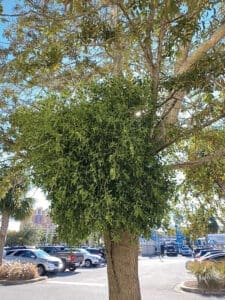 By Julie McConnell, UF/IFAS Extension Bay County
By Julie McConnell, UF/IFAS Extension Bay County
As we enter the holiday season, a common item of décor is mistletoe. The tradition of stealing a kiss beneath mistletoe hung in a doorway goes all the way back to the 16th century. Historically, this toxic plant was used to treat ailments such as epilepsy, toothaches, and convulsions although the side effects include nausea, blurred vision, and diarrhea. Ingestion of any portion of this plant is not recommended and hands should be thoroughly washed with soap and water after handling — consider using artificial mistletoe in the home!
 Although it is a pretty piece of greenery with an interesting background, mistletoe is not a welcome addition to trees in our landscape. Mistletoe is a hemiparasitic evergreen plant that lives in the branches of many tree species. In Florida, common hosts are laurel oak, but it will also infest other oaks, maples, sycamore, and elms. You may be asking, “what is a hemiparasite”? Hemi in Latin means half, so mistletoe is only partially parasitic, making food for itself in addition to taking water and nutrients from the tree.
Although it is a pretty piece of greenery with an interesting background, mistletoe is not a welcome addition to trees in our landscape. Mistletoe is a hemiparasitic evergreen plant that lives in the branches of many tree species. In Florida, common hosts are laurel oak, but it will also infest other oaks, maples, sycamore, and elms. You may be asking, “what is a hemiparasite”? Hemi in Latin means half, so mistletoe is only partially parasitic, making food for itself in addition to taking water and nutrients from the tree.
Typically, mistletoe will not kill a tree, after all it benefits from the tree remaining alive, but it can weaken it and make it more susceptible to other pests and disease. Over time this can shorten the lifespan of the tree. In this area of Florida where trees have been subjected to stressful environments such as hurricane strength winds and flooding, mistletoe can have more of a negative impact than on healthy trees.
Mistletoe is spread from tree to tree by birds. Birds eat the white berries which contain seeds and a sticky substance that is excreted after passing through the digestive tract. The sticky seeds cling to the feathers or feet of the bird and eventually get rubbed off in the branches of a new tree where it attaches, germinates, and roots into the branch of the new host.
Removing mistletoe is the most effective control measure but is difficult because it is often found high up in the tree canopy. To ensure that all the mistletoe roots are removed to prevent regrowth, it is recommended that you remove six inches of the branch back towards the trunk of the tree from the visible point of attachment. Although effective this can affect the aesthetics and potentially the structure of the tree. Sometimes it is not practical to take any action if it is unsafe or the structural integrity of the tree will be compromised.
As trees lose their leaves this winter, it is easier to spot tufts of mistletoe in branches since it remains evergreen. If infestation is heavy and higher than you can safely access, consult with an arborist for management strategies. To find a certified arborist or verify credentials visit www.treesaregood.org/findanarborist.
Julie McConnell can be reached at juliebmcconnell@ufl.edu. An Equal Opportunity Institution. UF/IFAS Extension, University of Florida, Institute of Food and Agricultural Sciences, Nick T. Place, dean for UF/IFAS Extension. Single copies of UF/IFAS Extension publications (excluding 4-H and youth publications) are available free to Florida residents from county UF/IFAS Extension offices.





















































